 Back to Archaeological Sites
Back to Archaeological Sites
Index of the First Nations of the Pacific Northwest Coast
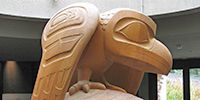 In the Pacific Northwest Coast mythology, Raven is the powerful figure who transforms the world. Stories tell how Raven created the land, released the people from a cockle shell, and brought them fire. Raven stole the light and brought it out to light up the world. Yet Raven is a trickster—often selfish, hungry, and mischievous. He changes the world only by cleverly deceiving others in his never - ending quest for food.
In the Pacific Northwest Coast mythology, Raven is the powerful figure who transforms the world. Stories tell how Raven created the land, released the people from a cockle shell, and brought them fire. Raven stole the light and brought it out to light up the world. Yet Raven is a trickster—often selfish, hungry, and mischievous. He changes the world only by cleverly deceiving others in his never - ending quest for food.
Last updated Tuesday 14 September 2021
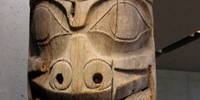 Totem Poles, House Posts, and Big Houses - The First Nations of the Pacific North West Coast at one time had the most densely populated areas of indigenous people. The land and waters provided rich natural resources through cedar and salmon, and highly structured cultures developed from relatively dense populations. Within the Pacific Northwest, many different nations developed, each with their own distinct history, culture, and society. Art provided Indigenous people with a tie to the land by depicting their histories on totem poles the Big Houses of the Pacific Northwest coast – the symbols depicted were a constant reminder of their birth places, lineages and nations.
Totem Poles, House Posts, and Big Houses - The First Nations of the Pacific North West Coast at one time had the most densely populated areas of indigenous people. The land and waters provided rich natural resources through cedar and salmon, and highly structured cultures developed from relatively dense populations. Within the Pacific Northwest, many different nations developed, each with their own distinct history, culture, and society. Art provided Indigenous people with a tie to the land by depicting their histories on totem poles the Big Houses of the Pacific Northwest coast – the symbols depicted were a constant reminder of their birth places, lineages and nations.
Last updated Sunday 13 July 2025
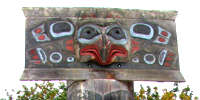 Mortuary poles - the term Totem Pole refers to the tall cedar poles with multiple figures carved by Native people of the northern Northwest Coast. Several different types of monumental poles include: Mortuary poles made in the nineteenth century which housed the coffins of important people in a niche at the top; free standing memorial poles placed in front of houses to honour deceased chiefs; house frontal poles placed against the house front, often serving as doorways of houses; carved interior house posts that support roof beams. Carved of red cedar logs, the figures on totem poles are inherited crests, which identify the pole owners and tell their family histories.
Mortuary poles - the term Totem Pole refers to the tall cedar poles with multiple figures carved by Native people of the northern Northwest Coast. Several different types of monumental poles include: Mortuary poles made in the nineteenth century which housed the coffins of important people in a niche at the top; free standing memorial poles placed in front of houses to honour deceased chiefs; house frontal poles placed against the house front, often serving as doorways of houses; carved interior house posts that support roof beams. Carved of red cedar logs, the figures on totem poles are inherited crests, which identify the pole owners and tell their family histories.
Last updated Friday 20 June 2025
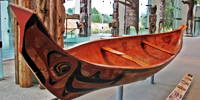 The First Nations people of the Northwest Coast are renowned for their elegantly engineered canoes. Ranging in length from three to twenty metres, canoes were essential for travel, transport, hunting, and trade. Each canoe is made from a single cedar log, carved and steamed into shape. Haida canoes were exquisite craft hewn from the gigantic red cedar that grows on Haida Gwaii and were highly prized by chiefs of other nations throughout the coast. Canoemakers in each village worked on their new craft throughout the autumn at sites where the very best red cedars stood. After an appropriate snowfall that facilitated sledding, the roughed-out canoes were moved from the woods to the nearest beach and towed to the home village, where they were finished over the winter.
The First Nations people of the Northwest Coast are renowned for their elegantly engineered canoes. Ranging in length from three to twenty metres, canoes were essential for travel, transport, hunting, and trade. Each canoe is made from a single cedar log, carved and steamed into shape. Haida canoes were exquisite craft hewn from the gigantic red cedar that grows on Haida Gwaii and were highly prized by chiefs of other nations throughout the coast. Canoemakers in each village worked on their new craft throughout the autumn at sites where the very best red cedars stood. After an appropriate snowfall that facilitated sledding, the roughed-out canoes were moved from the woods to the nearest beach and towed to the home village, where they were finished over the winter.
Last updated Wednesday 03 October 2018
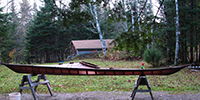 This is a superb account by David Smith of the step by step construction of a traditional Greenland-style kayak straight from a standing tree without using nails, screws, or other metal fastenings.
This is a superb account by David Smith of the step by step construction of a traditional Greenland-style kayak straight from a standing tree without using nails, screws, or other metal fastenings.
Last updated Friday 14 May 2021
 This page contains designs for some of the canoes of the First Nations people of the Northwest Coast. I would be grateful if any reader has other examples they would be willing to share.
This page contains designs for some of the canoes of the First Nations people of the Northwest Coast. I would be grateful if any reader has other examples they would be willing to share.
Last updated Sunday 02 September 2018
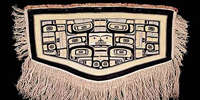 The First Nations people of the Northwest Coast have a very rich tradition of hats, cloaks, body armour, weaving, and masks. Before Europeans arrived and introduced cloth, most coastal people wore minimal clothing. Men went naked when weather permitted and women would wear a simple skirt made of shredded cedar fibre. Both sexes wore woven bark capes and spruce root hats as a protection from the rain.
The First Nations people of the Northwest Coast have a very rich tradition of hats, cloaks, body armour, weaving, and masks. Before Europeans arrived and introduced cloth, most coastal people wore minimal clothing. Men went naked when weather permitted and women would wear a simple skirt made of shredded cedar fibre. Both sexes wore woven bark capes and spruce root hats as a protection from the rain.
Last updated Wednesday 08 September 2021
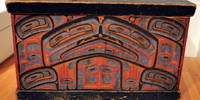 When thinking of the artefacts of the First Nations of the Pacific Northwest Coast most people will think of the massive totem poles, dugout canoes and sculptural masks, but the kerf-bent wooden box is the more ingenious example of a woodworking technology developed through eons of practice. It consists of just two planks of cedar. One is the flat bottom, rabbeted all around to receive the sides. The other is a single plank that has been deeply kerfed in three places, plasticised by controlled steam and bent at right angles to form four sides. The last corner is sewn or pegged together. The result will hold water. These richly decorated boxes range in size from a few inches to several feet. Some have flat sides, some bulge outward. Some have lids, some have sweeping curves cut into their top edges. They stored the food and possessions of everyday life as well as the ceremonial regalia of the winter dances, they were cooking pots and serving dishes, and finally they were coffins. But they were not merely containers as we think of containers, for their intricate motifs also represented the personal crests of the owner. These crests were displayed proudly, for they served to verify rank as well as spiritual power.
When thinking of the artefacts of the First Nations of the Pacific Northwest Coast most people will think of the massive totem poles, dugout canoes and sculptural masks, but the kerf-bent wooden box is the more ingenious example of a woodworking technology developed through eons of practice. It consists of just two planks of cedar. One is the flat bottom, rabbeted all around to receive the sides. The other is a single plank that has been deeply kerfed in three places, plasticised by controlled steam and bent at right angles to form four sides. The last corner is sewn or pegged together. The result will hold water. These richly decorated boxes range in size from a few inches to several feet. Some have flat sides, some bulge outward. Some have lids, some have sweeping curves cut into their top edges. They stored the food and possessions of everyday life as well as the ceremonial regalia of the winter dances, they were cooking pots and serving dishes, and finally they were coffins. But they were not merely containers as we think of containers, for their intricate motifs also represented the personal crests of the owner. These crests were displayed proudly, for they served to verify rank as well as spiritual power.
Last updated Wednesday 06 May 2020
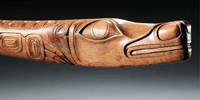
Artefacts of the First Nations of the Pacific North West Coast - the creation of beautiful and practical objects for all tribal communities served as a means of transmitting stories, history, wisdom and property from generation to generation. They had the time and the wealth to create superbly made tools, bowls, and magical objects.
Last updated Sunday 12 September 2021
 A potlatch is a gift-giving festival and primary economic system practiced by indigenous peoples of the Pacific Northwest Coast of Canada and United States. At potlatch gatherings, a family or hereditary leader hosts guests in their family's house and holds a feast for their guests. The main purpose of the potlatch is the re-distribution and reciprocity of wealth. Different events take place during a potlatch, like singing and dancing, sometimes with masks or the real regalia, such as Chilkat blankets, the barter of wealth through gifts, such as dried foods, sugar, flour, or other material things, and sometimes money. For many potlatches, spiritual ceremonies take place for different occasions. This is either through material wealth such as foods and goods or non-material things such as songs and dances. Many of these dances are also sacred ceremonies of secret societies. Typically the potlatching is practiced more in the winter seasons as historically the warmer months were for procuring wealth for the family, clan, or village, then coming home and sharing that with neighbours and friends.
A potlatch is a gift-giving festival and primary economic system practiced by indigenous peoples of the Pacific Northwest Coast of Canada and United States. At potlatch gatherings, a family or hereditary leader hosts guests in their family's house and holds a feast for their guests. The main purpose of the potlatch is the re-distribution and reciprocity of wealth. Different events take place during a potlatch, like singing and dancing, sometimes with masks or the real regalia, such as Chilkat blankets, the barter of wealth through gifts, such as dried foods, sugar, flour, or other material things, and sometimes money. For many potlatches, spiritual ceremonies take place for different occasions. This is either through material wealth such as foods and goods or non-material things such as songs and dances. Many of these dances are also sacred ceremonies of secret societies. Typically the potlatching is practiced more in the winter seasons as historically the warmer months were for procuring wealth for the family, clan, or village, then coming home and sharing that with neighbours and friends.
Last updated Saturday 27 January 2024
 Back to Archaeological Sites
Back to Archaeological Sites
 Back to Archaeological Sites
Back to Archaeological Sites
 This is a superb account by David Smith of the step by step construction of a traditional Greenland-style kayak straight from a standing tree without using nails, screws, or other metal fastenings.
This is a superb account by David Smith of the step by step construction of a traditional Greenland-style kayak straight from a standing tree without using nails, screws, or other metal fastenings.
 This page contains designs for some of the canoes of the First Nations people of the Northwest Coast. I would be grateful if any reader has other examples they would be willing to share.
This page contains designs for some of the canoes of the First Nations people of the Northwest Coast. I would be grateful if any reader has other examples they would be willing to share.

 Back to Archaeological Sites
Back to Archaeological Sites
 In the Pacific Northwest Coast mythology, Raven is the powerful figure who transforms the world. Stories tell how Raven created the land, released the people from a cockle shell, and brought them fire. Raven stole the light and brought it out to light up the world. Yet Raven is a trickster—often selfish, hungry, and mischievous. He changes the world only by cleverly deceiving others in his never - ending quest for food.
In the Pacific Northwest Coast mythology, Raven is the powerful figure who transforms the world. Stories tell how Raven created the land, released the people from a cockle shell, and brought them fire. Raven stole the light and brought it out to light up the world. Yet Raven is a trickster—often selfish, hungry, and mischievous. He changes the world only by cleverly deceiving others in his never - ending quest for food.
 Totem Poles, House Posts, and Big Houses - The First Nations of the Pacific North West Coast at one time had the most densely populated areas of indigenous people. The land and waters provided rich natural resources through cedar and salmon, and highly structured cultures developed from relatively dense populations. Within the Pacific Northwest, many different nations developed, each with their own distinct history, culture, and society. Art provided Indigenous people with a tie to the land by depicting their histories on totem poles the Big Houses of the Pacific Northwest coast – the symbols depicted were a constant reminder of their birth places, lineages and nations.
Totem Poles, House Posts, and Big Houses - The First Nations of the Pacific North West Coast at one time had the most densely populated areas of indigenous people. The land and waters provided rich natural resources through cedar and salmon, and highly structured cultures developed from relatively dense populations. Within the Pacific Northwest, many different nations developed, each with their own distinct history, culture, and society. Art provided Indigenous people with a tie to the land by depicting their histories on totem poles the Big Houses of the Pacific Northwest coast – the symbols depicted were a constant reminder of their birth places, lineages and nations.
 Mortuary poles - the term Totem Pole refers to the tall cedar poles with multiple figures carved by Native people of the northern Northwest Coast. Several different types of monumental poles include: Mortuary poles made in the nineteenth century which housed the coffins of important people in a niche at the top; free standing memorial poles placed in front of houses to honour deceased chiefs; house frontal poles placed against the house front, often serving as doorways of houses; carved interior house posts that support roof beams. Carved of red cedar logs, the figures on totem poles are inherited crests, which identify the pole owners and tell their family histories.
Mortuary poles - the term Totem Pole refers to the tall cedar poles with multiple figures carved by Native people of the northern Northwest Coast. Several different types of monumental poles include: Mortuary poles made in the nineteenth century which housed the coffins of important people in a niche at the top; free standing memorial poles placed in front of houses to honour deceased chiefs; house frontal poles placed against the house front, often serving as doorways of houses; carved interior house posts that support roof beams. Carved of red cedar logs, the figures on totem poles are inherited crests, which identify the pole owners and tell their family histories.
 The First Nations people of the Northwest Coast are renowned for their elegantly engineered canoes. Ranging in length from three to twenty metres, canoes were essential for travel, transport, hunting, and trade. Each canoe is made from a single cedar log, carved and steamed into shape. Haida canoes were exquisite craft hewn from the gigantic red cedar that grows on Haida Gwaii and were highly prized by chiefs of other nations throughout the coast. Canoemakers in each village worked on their new craft throughout the autumn at sites where the very best red cedars stood. After an appropriate snowfall that facilitated sledding, the roughed-out canoes were moved from the woods to the nearest beach and towed to the home village, where they were finished over the winter.
The First Nations people of the Northwest Coast are renowned for their elegantly engineered canoes. Ranging in length from three to twenty metres, canoes were essential for travel, transport, hunting, and trade. Each canoe is made from a single cedar log, carved and steamed into shape. Haida canoes were exquisite craft hewn from the gigantic red cedar that grows on Haida Gwaii and were highly prized by chiefs of other nations throughout the coast. Canoemakers in each village worked on their new craft throughout the autumn at sites where the very best red cedars stood. After an appropriate snowfall that facilitated sledding, the roughed-out canoes were moved from the woods to the nearest beach and towed to the home village, where they were finished over the winter.
 The First Nations people of the Northwest Coast have a very rich tradition of hats, cloaks, body armour, weaving, and masks. Before Europeans arrived and introduced cloth, most coastal people wore minimal clothing. Men went naked when weather permitted and women would wear a simple skirt made of shredded cedar fibre. Both sexes wore woven bark capes and spruce root hats as a protection from the rain.
The First Nations people of the Northwest Coast have a very rich tradition of hats, cloaks, body armour, weaving, and masks. Before Europeans arrived and introduced cloth, most coastal people wore minimal clothing. Men went naked when weather permitted and women would wear a simple skirt made of shredded cedar fibre. Both sexes wore woven bark capes and spruce root hats as a protection from the rain.
 When thinking of the artefacts of the First Nations of the Pacific Northwest Coast most people will think of the massive totem poles, dugout canoes and sculptural masks, but the kerf-bent wooden box is the more ingenious example of a woodworking technology developed through eons of practice. It consists of just two planks of cedar. One is the flat bottom, rabbeted all around to receive the sides. The other is a single plank that has been deeply kerfed in three places, plasticised by controlled steam and bent at right angles to form four sides. The last corner is sewn or pegged together. The result will hold water. These richly decorated boxes range in size from a few inches to several feet. Some have flat sides, some bulge outward. Some have lids, some have sweeping curves cut into their top edges. They stored the food and possessions of everyday life as well as the ceremonial regalia of the winter dances, they were cooking pots and serving dishes, and finally they were coffins. But they were not merely containers as we think of containers, for their intricate motifs also represented the personal crests of the owner. These crests were displayed proudly, for they served to verify rank as well as spiritual power.
When thinking of the artefacts of the First Nations of the Pacific Northwest Coast most people will think of the massive totem poles, dugout canoes and sculptural masks, but the kerf-bent wooden box is the more ingenious example of a woodworking technology developed through eons of practice. It consists of just two planks of cedar. One is the flat bottom, rabbeted all around to receive the sides. The other is a single plank that has been deeply kerfed in three places, plasticised by controlled steam and bent at right angles to form four sides. The last corner is sewn or pegged together. The result will hold water. These richly decorated boxes range in size from a few inches to several feet. Some have flat sides, some bulge outward. Some have lids, some have sweeping curves cut into their top edges. They stored the food and possessions of everyday life as well as the ceremonial regalia of the winter dances, they were cooking pots and serving dishes, and finally they were coffins. But they were not merely containers as we think of containers, for their intricate motifs also represented the personal crests of the owner. These crests were displayed proudly, for they served to verify rank as well as spiritual power.
 A potlatch is a gift-giving festival and primary economic system practiced by indigenous peoples of the Pacific Northwest Coast of Canada and United States. At potlatch gatherings, a family or hereditary leader hosts guests in their family's house and holds a feast for their guests. The main purpose of the potlatch is the re-distribution and reciprocity of wealth. Different events take place during a potlatch, like singing and dancing, sometimes with masks or the real regalia, such as Chilkat blankets, the barter of wealth through gifts, such as dried foods, sugar, flour, or other material things, and sometimes money. For many potlatches, spiritual ceremonies take place for different occasions. This is either through material wealth such as foods and goods or non-material things such as songs and dances. Many of these dances are also sacred ceremonies of secret societies. Typically the potlatching is practiced more in the winter seasons as historically the warmer months were for procuring wealth for the family, clan, or village, then coming home and sharing that with neighbours and friends.
A potlatch is a gift-giving festival and primary economic system practiced by indigenous peoples of the Pacific Northwest Coast of Canada and United States. At potlatch gatherings, a family or hereditary leader hosts guests in their family's house and holds a feast for their guests. The main purpose of the potlatch is the re-distribution and reciprocity of wealth. Different events take place during a potlatch, like singing and dancing, sometimes with masks or the real regalia, such as Chilkat blankets, the barter of wealth through gifts, such as dried foods, sugar, flour, or other material things, and sometimes money. For many potlatches, spiritual ceremonies take place for different occasions. This is either through material wealth such as foods and goods or non-material things such as songs and dances. Many of these dances are also sacred ceremonies of secret societies. Typically the potlatching is practiced more in the winter seasons as historically the warmer months were for procuring wealth for the family, clan, or village, then coming home and sharing that with neighbours and friends.